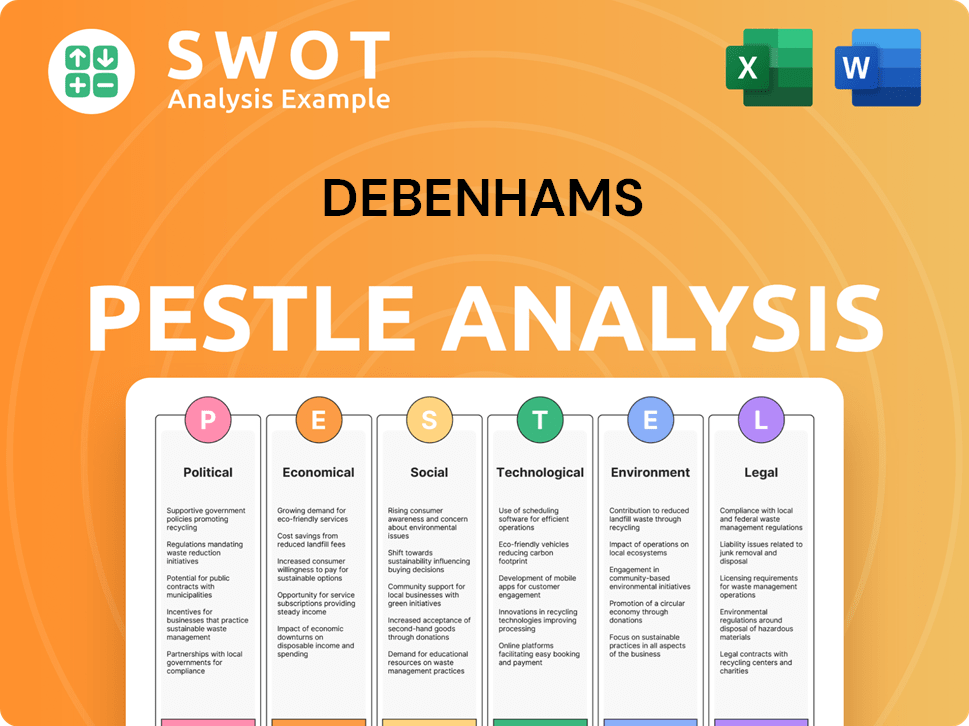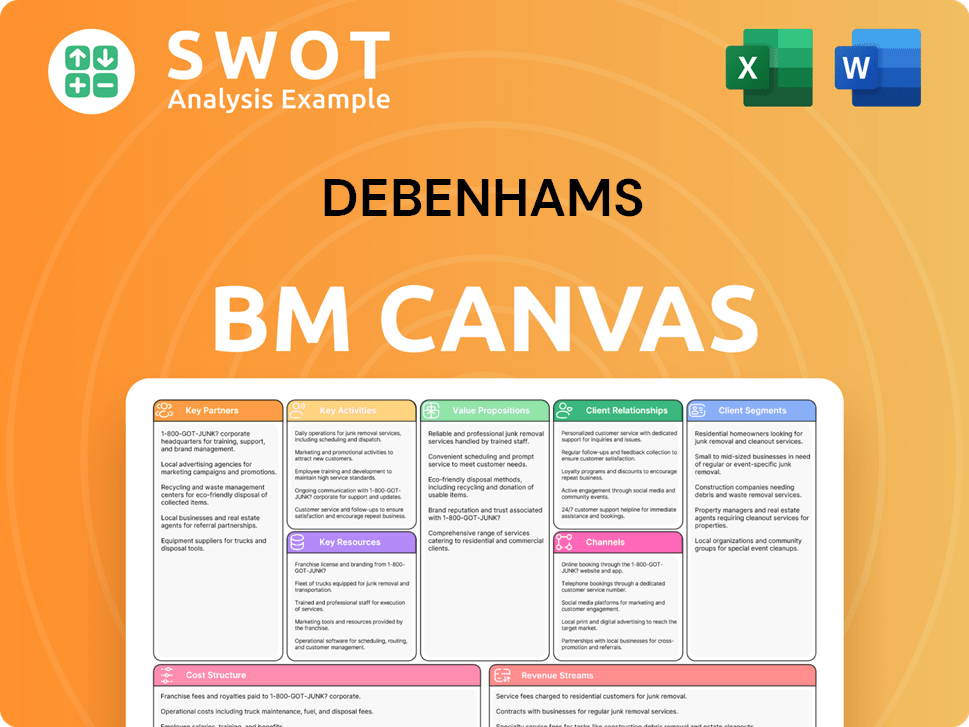Debenhams Bundle
Can Debenhams Reclaim its Retail Throne?
The retail landscape is in constant flux, demanding innovative growth strategies for survival. Debenhams, a British retail icon, has undergone a dramatic transformation, shifting from its traditional department store model to an online-first approach. This strategic pivot, spearheaded by Boohoo Group, presents a fascinating case study in adapting to the evolving demands of the Debenhams SWOT Analysis.

This analysis delves into the Debenhams growth strategy, exploring its future prospects within the dynamic UK retail sector. We'll examine the Debenhams company analysis, including its business model evolution, expansion plans, and the challenges it faces in a competitive department store market. Understanding Debenhams' journey offers valuable insights into retail industry trends and the strategies needed to thrive in the digital age, making this a critical read for investors and business strategists alike.
How Is Debenhams Expanding Its Reach?
The expansion initiatives of the Debenhams Group are primarily focused on leveraging its successful marketplace model. These initiatives aim to extend its reach both geographically and across product categories, representing a key component of the Debenhams growth strategy. The company is strategically entering new international markets to broaden its consumer base and increase its market share.
A significant aspect of this expansion involves launching new websites in Ireland and Australia before the Christmas shopping season. This international push is designed to cater to diverse global consumers, offering a wide array of local and international brands. The company is also focused on enhancing its fulfillment services to support its expansion, streamlining operations and strengthening partnerships with various brands.
The marketplace model is a core expansion strategy, enabling third-party brands to sell through its platform, thereby diversifying revenue streams and reducing inventory risk. This approach has shown significant growth, with Debenhams Marketplace and Beauty experiencing over 170% year-on-year GMV growth in the first half of FY25, onboarding over 10,000 brands.
Debenhams plans to launch new websites in Ireland and Australia, targeting diverse global consumers. This strategy aims to broaden the company's reach and increase sales. The focus is on providing access to hundreds of local and international brands to meet consumer demands.
The marketplace model allows third-party brands to sell on the platform, diversifying revenue and reducing inventory risk. Debenhams Marketplace and Beauty saw over 170% year-on-year GMV growth in the first half of FY25. Over 10,000 brands have been onboarded, indicating strong growth potential.
UK brand partners can now store and dispatch stock from Boohoo Group's automated distribution center in Sheffield. This offers customers next-day delivery and streamlines operations. It supports the 'stock-lite' and 'capital-lite' nature of the marketplace model.
The group intends to pivot its youth brands (Boohoo, PrettyLittleThing, and MAN) to fashion-led marketplaces. This move aims to enhance consumer experience and reduce future stockholding requirements. The focus is on increasing market share through this strategic shift.
The company's expansion strategy is multi-faceted, involving international market entry, marketplace growth, and enhanced fulfillment services. These initiatives are designed to capitalize on the Debenhams future prospects and adapt to evolving retail industry trends.
- Geographic expansion through new website launches in Ireland and Australia.
- Growth of the marketplace model, onboarding over 10,000 brands.
- Enhancement of fulfillment services to support faster delivery times.
- Transformation of youth brands into fashion-led marketplaces.
- Evolution of Karen Millen into a premium lifestyle destination.
Debenhams SWOT Analysis
- Complete SWOT Breakdown
- Fully Customizable
- Editable in Excel & Word
- Professional Formatting
- Investor-Ready Format

How Does Debenhams Invest in Innovation?
The evolution of the retail landscape necessitates that businesses like Debenhams adapt and innovate to meet the ever-changing customer needs and preferences. The company's growth strategy centers on leveraging technology to enhance the shopping experience and streamline operations. This focus reflects a broader trend in the retail industry, where digital transformation is crucial for survival and success.
Understanding the department store market and the UK retail sector is vital for Debenhams' future prospects. The company is investing in areas such as augmented reality (AR) and artificial intelligence (AI) to stay ahead of the curve. These innovations aim to provide personalized shopping experiences and increase customer engagement, which is essential for building brand loyalty and driving sales.
Debenhams' commitment to innovation and technology is evident in its strategic investments aimed at enhancing the customer experience and streamlining operations. This approach is crucial for competing in the dynamic retail environment.
Debenhams utilizes proprietary technology, particularly the Mirakl Marketplace Platform, to manage its marketplace-led business model. This technology allows for the rapid integration of new brands, with approximately 200 new suppliers onboarded weekly for the Boohoo brands marketplace.
Digital transformation is a core element of Debenhams' strategy, focusing on personalized shopping, streamlined operations, and efficient service delivery. The company is investing in e-commerce and digital marketing to reach a wider audience.
In May 2025, Debenhams launched virtual try-on technology, initially for beauty products, with plans to expand into fashion. This AR feature aims to enhance personalization and boost customer confidence in purchases.
The company plans to launch an AI room builder and already utilizes virtual advisors. These initiatives are part of a broader effort to integrate AR to enhance the online shopping journey. The global AR in retail market is projected to grow significantly.
Debenhams continuously updates its product offerings and invests in digital marketing and e-commerce. These efforts are designed to reach a wider audience and maintain a competitive edge in the market.
Debenhams' strategy emphasizes its online presence and e-commerce capabilities. Investments in digital marketing and e-commerce are essential for reaching a wider customer base and staying competitive in the evolving retail landscape.
Debenhams' innovation strategy focuses on leveraging technology to enhance customer experience and operational efficiency. Key areas of investment include marketplace technology, digital transformation, and the integration of AR and AI.
- Marketplace Platform: Utilizes Mirakl Marketplace Platform for efficient brand integration.
- AR and AI: Implements virtual try-on technology and plans AI room builders to enhance the online shopping journey.
- Digital Marketing: Invests in digital marketing and e-commerce to expand its reach and stay competitive.
- Customer Experience: Focuses on personalized shopping experiences, streamlined operations, and efficient service delivery.
- Continuous Updates: Regularly updates product offerings and marketing strategies to meet evolving customer needs.
For more insights into the broader strategies employed by Debenhams, including its marketing efforts, consider reading about the Marketing Strategy of Debenhams.
Debenhams PESTLE Analysis
- Covers All 6 PESTLE Categories
- No Research Needed – Save Hours of Work
- Built by Experts, Trusted by Consultants
- Instant Download, Ready to Use
- 100% Editable, Fully Customizable

What Is Debenhams’s Growth Forecast?
The financial outlook for the former Boohoo Group, particularly concerning its Debenhams division, is showing positive signs. The company's Debenhams growth strategy focuses on its online marketplace, which has demonstrated strong performance. This shift is crucial within the context of retail industry trends and the evolving department store market.
For the fiscal year ending February 2025, Debenhams achieved a gross merchandise value (GMV) of £654 million, significantly up from £489 million the previous year. This growth is a key indicator of the company's turnaround strategy. The Debenhams company analysis reveals a strategic focus on the expansion of its marketplace model, which is expected to drive future revenue. This emphasis on online presence and e-commerce is vital for its future prospects.
The group's overall revenue for FY25 decreased by 16% to £1.22 billion. However, the Debenhams segment showed strong growth, highlighting the success of its strategic shift. The company is targeting an EBITDA margin of approximately 20% on a net sales basis for Debenhams in the medium term. For a deeper understanding of the company's revenue streams and business model, you can refer to this article: Revenue Streams & Business Model of Debenhams.
Debenhams reported a significant increase in GMV, reaching £654 million in FY25. Sales reached £205 million, with an EBITDA margin of approximately 12%. This performance underscores the company's growth trajectory within the UK retail sector.
The company aims to create a multi-billion pound GMV business in the medium term. It targets an EBITDA margin of approximately 20% on net sales for the Debenhams segment. This ambitious goal reflects its expansion plans and strategies.
The group has focused on cash generation and operational efficiency, significantly reducing capital expenditure. The sale of its London head office for £49.5 million in December 2024 strengthened its balance sheet. This demonstrates effective supply chain management.
Net debt increased to £143.1 million in the first half of FY25. However, the group secured a new £222 million debt financing agreement in October 2024. In December 2024, £97 million of debt was repaid.
The financial strategy includes a focus on cost control and debt management. The company is navigating challenges and opportunities within the department store market.
- GMV for Debenhams reached £654 million in FY25.
- EBITDA margin for Debenhams is targeted at approximately 20%.
- The group is focused on cash generation and operational efficiency.
- A new £222 million debt financing agreement was signed in October 2024.
Debenhams Business Model Canvas
- Complete 9-Block Business Model Canvas
- Effortlessly Communicate Your Business Strategy
- Investor-Ready BMC Format
- 100% Editable and Customizable
- Clear and Structured Layout

What Risks Could Slow Debenhams’s Growth?
The Debenhams Group faces several significant risks and obstacles as it pursues its growth strategy, particularly in the evolving retail landscape. These challenges could affect the company's ability to achieve its goals and impact its future prospects. Understanding these risks is crucial for a comprehensive Debenhams company analysis.
Intense competition, integrating diverse brands, and supply chain vulnerabilities are among the primary concerns. The group's turnaround strategy and future success depend on navigating these challenges effectively. The dynamic nature of the retail industry demands constant adaptation and strategic foresight to mitigate potential setbacks.
The Debenhams growth strategy is further complicated by the need to integrate diverse brands, each with its own business model and target audience, into a cohesive marketplace. The successful execution of this integration is vital for the overall performance of the group. This transformation necessitates a deep understanding of each brand's customer base and a strategic approach to avoid alienating existing customers.
The retail industry trends show increased competition from both traditional retailers and fast-fashion brands like Shein and Temu. These competitors disrupt the market with lower prices and faster production cycles, impacting sales, especially within the group's youth brands. The department store market is highly competitive, requiring Debenhams to innovate and differentiate itself.
Integrating various brands, including fast-fashion labels, into the marketplace model is a substantial operational hurdle. These brands have differing business models and target audiences. Successfully merging them requires careful strategic planning to avoid alienating existing customers. The turnaround of youth brands is expected to take time and substantial change.
Supply chain vulnerabilities and rising returns pose significant challenges. While the marketplace model aims to mitigate inventory risk, efficient logistics and supply chain management remain crucial. Technological disruption requires continuous investment in cutting-edge technologies to maintain a competitive edge. The UK retail sector faces ongoing logistical challenges.
The rapidly evolving retail landscape necessitates continuous investment in cutting-edge technologies to maintain a competitive edge. E-commerce and online presence are critical for Debenhams' future prospects. Adapting to technological advancements is essential for survival in the department store market. The challenges and opportunities presented by technology are significant.
Regulatory changes and internal resource constraints could impact the group's ability to execute its ambitious growth plans. The impact of Brexit on business continues to be a factor. Efficient management of resources is vital for success. Debenhams must navigate these constraints effectively.
The shift to a marketplace model requires careful management to ensure partner performance and customer satisfaction. Maintaining brand image and customer experience is crucial. The Debenhams business model evolution is a key aspect of its turnaround strategy, but it faces operational hurdles.
Management is implementing strategic restructuring, including workforce reductions and warehouse consolidation, aiming for approximately £150 million in annual cost savings. This focus emphasizes cash generation and operational efficiency. These measures are part of the Debenhams turnaround strategy. Financial performance analysis will be crucial to assess the effectiveness of these measures.
The successful turnaround of Debenhams itself, which has proven its marketplace model and profitability, serves as a blueprint for the wider group turnaround. This includes a focus on online presence and e-commerce. The Debenhams brand positioning and image are key to this strategy. The company's expansion plans and strategies are built on this foundation.
For a deeper dive into the competitive landscape, consider exploring the Competitors Landscape of Debenhams. While the marketplace model aims to mitigate inventory risk, efficient logistics and supply chain management remain crucial for timely delivery and customer satisfaction. The company's ability to manage these risks will significantly influence its future prospects.
Debenhams Porter's Five Forces Analysis
- Covers All 5 Competitive Forces in Detail
- Structured for Consultants, Students, and Founders
- 100% Editable in Microsoft Word & Excel
- Instant Digital Download – Use Immediately
- Compatible with Mac & PC – Fully Unlocked

Related Blogs
- What are Mission Vision & Core Values of Debenhams Company?
- What is Competitive Landscape of Debenhams Company?
- How Does Debenhams Company Work?
- What is Sales and Marketing Strategy of Debenhams Company?
- What is Brief History of Debenhams Company?
- Who Owns Debenhams Company?
- What is Customer Demographics and Target Market of Debenhams Company?
Disclaimer
All information, articles, and product details provided on this website are for general informational and educational purposes only. We do not claim any ownership over, nor do we intend to infringe upon, any trademarks, copyrights, logos, brand names, or other intellectual property mentioned or depicted on this site. Such intellectual property remains the property of its respective owners, and any references here are made solely for identification or informational purposes, without implying any affiliation, endorsement, or partnership.
We make no representations or warranties, express or implied, regarding the accuracy, completeness, or suitability of any content or products presented. Nothing on this website should be construed as legal, tax, investment, financial, medical, or other professional advice. In addition, no part of this site—including articles or product references—constitutes a solicitation, recommendation, endorsement, advertisement, or offer to buy or sell any securities, franchises, or other financial instruments, particularly in jurisdictions where such activity would be unlawful.
All content is of a general nature and may not address the specific circumstances of any individual or entity. It is not a substitute for professional advice or services. Any actions you take based on the information provided here are strictly at your own risk. You accept full responsibility for any decisions or outcomes arising from your use of this website and agree to release us from any liability in connection with your use of, or reliance upon, the content or products found herein.